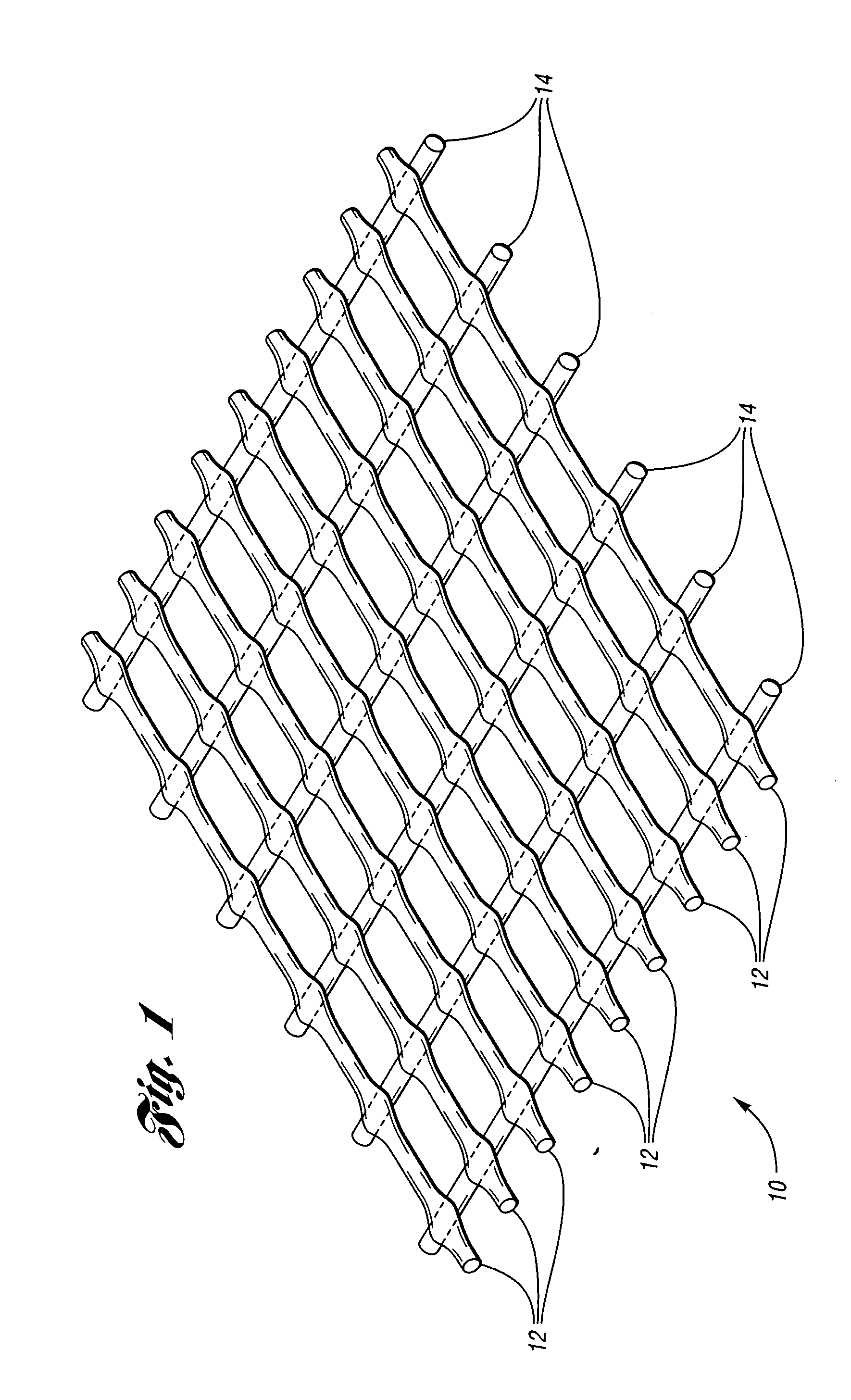Biodegradable netting
a technology of netting and biodegradable materials, applied in the field of biodegradable netting, can solve the problems of netting's folding point being particularly sensitive to damage, plastic material being completely transformed, and being more susceptible to damage in this transformation process
- Summary
- Abstract
- Description
- Claims
- Application Information
AI Technical Summary
Benefits of technology
Problems solved by technology
Method used
Image
Examples
example 1
[0082] An extruded netting is produced at a basis weight of 220 gsm (grams / m2) and a total width of 44.5 inches. The biodegradable raw material composition is 70.0% NatureWorks™ 5040D polylactic acid resin from Cargill Dow, and 30.0% Eastar Bio Ultra aliphatic-aromatic polyester from Eastman Chemical. The extruded netting's machine direction (MD) breaking load is 4.0 lbs / strand, and its cross direction (CD) breaking load is 4.5 lbs / strand.
[0083] The extruded netting is subsequently biaxially oriented by first stretching the extruded netting in the machine direction at a temperature of 200° F. The netting is then immediately stretched in the cross direction at a temperature of 120-175° F. The resulting biaxially oriented netting has 1.3 strands per inch in the MD and 0.6 strands per inch in the CD. The average MD breaking load is 4.25 lbs / strand, and the average CD breaking load is 4.5 lbs / strand.
[0084] The oriented netting is then tested for aerobic biodegradation under controlled...
example 2
[0085] An extruded netting is produced at a basis weight of 220 gsm and a total width of 49.5 inches. The biodegradable raw material composition is 64.7% NatureWorks™ 5040D polylactic acid resin from Cargill Dow, 27.8% Eastar Bio Ultra aliphatic-aromatic polyester from Eastman Chemical, and 7.5% of a polypropylene homopolymer. The extruded netting's machine direction (MD) breaking load is 4.0 lbs / strand, and its cross direction (CD) breaking load is 4.5 lbs / strand.
[0086] The extruded netting is subsequently biaxially oriented by first stretching the extruded netting in the machine direction at a temperature of 200° F. The netting is then immediately stretched in the cross direction at a temperature of 120-175° F. The resulting biaxially oriented netting has 1.3 strands per inch in the MD and 0.6 strands per inch in the CD. The average MD breaking load is 4.25 lbs / strand, and the average CD breaking load is 4.5 lbs / strand.
[0087] The oriented netting is then tested for aerobic biode...
example 3
[0088] An extruded netting is produced at a basis weight of 220 gsm and a total width of 42.0 inches. The biodegradable raw material composition is 80.0% NatureWorks™ 5729B polylactic acid resin from Cargill Dow, and 20.0% Ecoflex F BX 7011 aliphatic-aromatic polyester from BASF. The extruded netting's machine direction (MD) breaking load is 4.0 lbs / strand, and its cross direction (CD) breaking load is 4.5 lbs / strand.
[0089] The extruded netting is subsequently biaxially oriented by first stretching the extruded netting in the machine direction at a temperature of 200° F. The netting is then immediately stretched in the cross direction at a temperature of 120-175° F. The resulting biaxially oriented netting has 1.3 strands per inch in the machine direction and 0.6 strands per inch in the cross direction. The average MD breaking load is 4.25 lbs / strand, and the average CD breaking load is 4.5 lbs / strand.
PUM
| Property | Measurement | Unit |
|---|---|---|
| Fraction | aaaaa | aaaaa |
| Fraction | aaaaa | aaaaa |
| Percent by mass | aaaaa | aaaaa |
Abstract
Description
Claims
Application Information
 Login to View More
Login to View More - R&D
- Intellectual Property
- Life Sciences
- Materials
- Tech Scout
- Unparalleled Data Quality
- Higher Quality Content
- 60% Fewer Hallucinations
Browse by: Latest US Patents, China's latest patents, Technical Efficacy Thesaurus, Application Domain, Technology Topic, Popular Technical Reports.
© 2025 PatSnap. All rights reserved.Legal|Privacy policy|Modern Slavery Act Transparency Statement|Sitemap|About US| Contact US: help@patsnap.com



